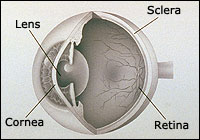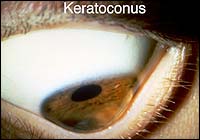What is Keratoconus?

The cornea is the clear window at the front of the eye.
Keratoconus is a condition where the cornea develops a distorted shape producing blurred vision. The eye is normally shaped round like a basketball. With nearsightedness, the cornea is too large and with farsightedness, the eye is too short. With astigmatism, the eye is shaped more like a football rather than a basketball. In other words, it is curved more in one direction than in the direction 90 degrees away. This “football shaped” cornea is what produces the distortion with astigmatism. Associated with this change in corneal shape, is a thinning of the central part of the cornea which eventually produces a “bulge” in the center of the cornea (see photo below). Thus, the name “keratoconus”. “Kerato” means cornea and “conus” means cone shaped. The conical shape produces distortion of vision.
The football shape analogy produces “regular” astigmatism. This is where the “football” or cornea is shaped differently but is a smooth curvature. In keratoconus, the cornea develops “irregular” astigmatism. This is where each direction of the football shaped cornea has a non-smooth surface much like the peaks and valleys of a mountain range. This produces severe distortion of vision.

This is an extreme example of keratoconus where the bulge in the center of the cornea distorts the lower eyelid as the patient looks downward.
Keratoconus usually develops by the late teens and twenties. After age 30, it rarely progresses any further although there are rare exceptions. There can be a family history of keratoconus and there seems to be a genetic link in some families. Also, patients with keratoconus have been found to have a greater incidence of atopic allergies much more commonly than the average patient. Also, the need to rub the eyes vigorously seems to be a common finding in some patients with this condition.
Treatment involves use of contact lenses and glasses. Usually, a rigid contact lens is fitted to the eye. This rigid lens smooths out the “peaks and valleys” in the cornea with irregular astigmatism. If there are too many peaks and valleys, specially designed keratoconus contact lenses are available including a unique contact lens that has a rigid center and soft periphery.
Sometimes, “hydrops” of the cornea can occur when the thinning produces swelling of the cornea as a result of weakening of the cells. This is often treated with eye drops in addition to contact lenses and glasses. If hydrops develops or if a patient is unable to wear contact lenses or if vision is not adequately restored with contact lenses and glasses, corneal transplantation can be the next step in treatment. Here, a donor cornea is used to replace the damaged cornea. A donor match is not required because the cornea has no blood vessels. Corneal transplantation has one of the highest success rates of any transplant operation. For keratoconus specifically, the success is well over 95%!
For more information, follow this link: National Keratoconus Foundation